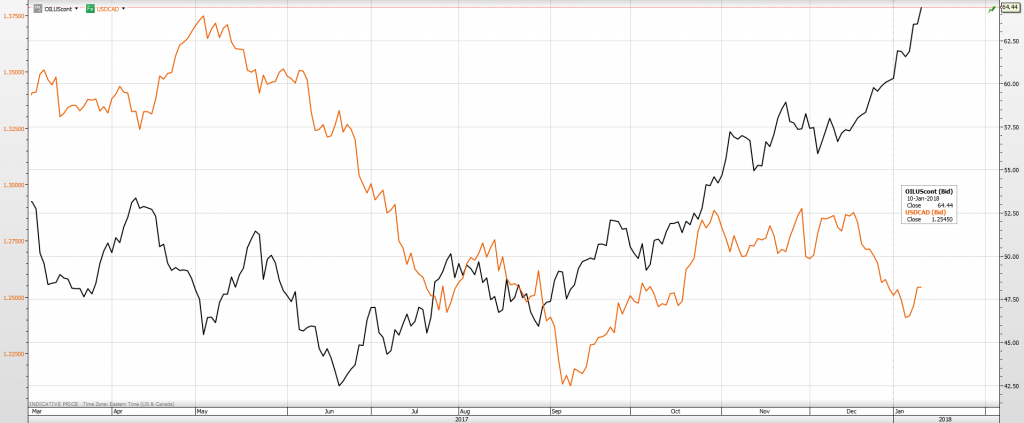By Michael O’Neill
The NAFTA negotiation train went off the tracks and took the 2018 Canadian dollar rally with it. On January 10, Reuters flashed a headline: Exclusive: Canada increasingly convinced Trump will pull out of NAFTA.”
The reaction was swift and furious. USDCAD soared, rising from an earlier low of 1.2420 to 1.2588 and turned a bearish USDCAD technical outlook to bullish.
Before the headline, everything was coming up roses for the Loonie.The Canadian dollar was in rally mode. USDCAD had declined 4.3% between December 19, 2017, and January 5, 2018. A few analysts expected those losses to extend to 1.1575, in a fall fueled by robust economic data, soaring oil prices and rising Bank of Canada (BoC) rate hike expectations. Many economists predicted that the Bank would raise interest rates three times in 2018, with more aggressive analysts suggesting four increase were likely.
On January 5, StatisticsCanada announced Canada had gained another 78,500 jobs, and the unemployment rate declined to 5.7%. a 40-year record low. The report convinced traders that the Bank of Canada would raise the overnight rate to 1.25% from 1.0% on January 17.
The NAFTA story altered the interest rate outlook.
The essence of the Reuters NAFTA story was two unnamed Canadian sources said Canada is increasingly convinced that the United States will pull out of NAFTA.
That was it, but the damage was done, even after the White House said: “there has been no change in the President’s position on NAFTA.” For many USDCAD traders, NAFTA concerns, which were on the back burner, flared up with all the intensity of a stove-top grease fire.

“NAFTA concerns flare up” Photo: Shutterstock
You may recall that Round 5 of the negotiations ended acrimoniously. The US made a series of demands that Canada and Mexico found hard to swallow. Those demands included raising US content in North American auto production, a 5-year term for any new deal and an end to third-party arbitration to settle disputes.
Perhaps the Reuters headline was a bluff by Canada to change the dynamics around the negotiating table. If so, Canada is holding very weak cards. Canada is only 15% of the total US trade while the US is 70% of the total Canada trade.
The Bank of Canada is certainly aware of the importance of the deal, despite NAFTA not making it into the top three things keeping Stephen Poloz awake at night. On December 14, the Governor delivered a somewhat dovish speech highlighting economic risks which included, cyber threats to the economy, elevated household debt and the low participation among youth in employment data. The fact that he didn’t mention the trade talks gave USDCAD bears some comfort.
Regardless, the BoC continues to state that “rate hikes are “data dependent” and the recent string of strong domestic data points to a rate hike on January 17.
If so, the impact on the currency may be like what occurred last September. Back then, the BoC raised interest rates 0.25% but issued a dovish statement. USDCAD rallied and continued to do so until the last week of the year.
If history repeats itself, the BoC will raise the overnight rate by 0.25 basis points but highlight risks to the economy, including the NAFTA negotiations. USDCAD losses would be limited.
The BoC could also leave rates unchanged but issue a hawkish policy statement, leaving the door wide open for a rate increase at the March meeting. If so, it could trigger added USDCAD buying. However, the above scenario is less likely because of the Bank’s insistence that ”Governing Council will continue to be cautious, guided by incoming data in assessing the economy’s sensitivity to interest rates, the evolution of economic capacity, and the dynamics of both wage growth and inflation.”
Another relationship that has gone off the rails is the Canadian dollar/West Texas Intermediate (WTI) oil correlation. Normally, when oil prices rise, the Canadian dollar rises as well. The relationship decoupled between September and mid-December and decoupled again at the start of the new year. Part of the reason for the discrepancy is that Canada’s major crude export, Western Canada Select, is a heavier oil that WTI, which requires additional refining. Recently, increased supply and pipeline constraints have led to a $31.99 Canadian dollar discount to the price of WTI. The price differential was just CAD 15.05 in July 2017. Even though oil prices have risen, the benefit to Canada is reduced.
Chart: USDCAD (orange line) and WTI (Black line)

The NAFTA headline derailed a Canadian dollar rally but that move easily gets put back on track if the BoC raises rates and the trade talks receive some positive press.





